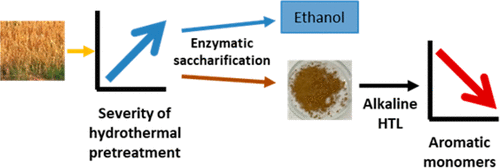当前位置:
X-MOL 学术
›
ACS Sustain. Chem. Eng.
›
论文详情
Our official English website, www.x-mol.net, welcomes your
feedback! (Note: you will need to create a separate account there.)
Hydrothermal Liquefaction of Enzymatic Hydrolysis Lignin: Biomass Pretreatment Severity Affects Lignin Valorization
ACS Sustainable Chemistry & Engineering ( IF 7.1 ) Pub Date : 2018-03-18 00:00:00 , DOI: 10.1021/acssuschemeng.7b04338 Mads M. Jensen 1 , Demi T. Djajadi 2 , Cristian Torri 3 , Helene B. Rasmussen 1 , René B. Madsen 1 , Elisa Venturini 4 , Ivano Vassura 4 , Jacob Becker 1 , Bo B. Iversen 1 , Anne S. Meyer 2 , Henning Jørgensen 2 , Daniele Fabbri 3 , Marianne Glasius 1
ACS Sustainable Chemistry & Engineering ( IF 7.1 ) Pub Date : 2018-03-18 00:00:00 , DOI: 10.1021/acssuschemeng.7b04338 Mads M. Jensen 1 , Demi T. Djajadi 2 , Cristian Torri 3 , Helene B. Rasmussen 1 , René B. Madsen 1 , Elisa Venturini 4 , Ivano Vassura 4 , Jacob Becker 1 , Bo B. Iversen 1 , Anne S. Meyer 2 , Henning Jørgensen 2 , Daniele Fabbri 3 , Marianne Glasius 1
Affiliation

|
Alkaline hydrothermal liquefaction (HTL) of lignin-rich enzymatic hydrolysis residues (EnzHR) from wheat straw and Miscanthus x giganteus was performed at 255, 300, and 345 °C to investigate valorization of this side-stream from second-generation bioethanol production. The EnzHR were from biomass hydrothermally pretreated at two different levels of severity (190 °C, 10 min or 195 °C, 15 min), and HTL at 300 °C of these EnzHR showed the most effective lignin depolymerization of the low severity EnzHR for both wheat straw and Miscanthus. The degree of depolymerization during HTL was temperature dependent and was not complete after 20 min at 255 °C, most distinctly for the Miscanthus EnzHR. The yields of 128 monomeric products quantified by gas chromatography–mass spectrometry were up to 15.4 wt % of dry matter. Principal component analysis of the quantified compounds showed that nonlignin HTL products are main contributors to the variance of the HTL products from the two biomasses. The chemically modified lignin polymer was found to have increased thermal stability after HTL. Analytical pyrolysis was applied to investigate the chemical composition of a larger fraction of the products. Analytical pyrolysis contributed with additional chemical information as well as confirming trends seen from quantified monomers. This work is relevant for future lignin valorization in biorefineries based on current second-generation bioethanol production.
中文翻译:

酶水解木质素的水热液化:生物量预处理的严重程度影响木质素的平衡。
在255、300和345°C下进行了小麦秸秆和芒草(Miscanthus x giganteus)中富含木质素的酶促水解残基(EnzHR)的碱性水热液化(HTL),以研究第二代生物乙醇生产中该支流的增值作用。EnzHR来自于在两种不同严重度下(190°C,10分钟或195°C,15分钟)进行水热预处理的生物质,这些EnzHR在300°C下的HTL显示低强度EnzHR对木质素的最有效解聚反应。麦秸和芒草。HTL期间的解聚程度与温度有关,并且在255°C下20分钟后未完全解聚,对于芒草最明显EnzHR。通过气相色谱-质谱法定量的128种单体产物的收率高达干物质的15.4 wt%。定量化合物的主成分分析表明,非木质素HTL产物是两种生物质中HTL产物变化的主要贡献者。发现经化学修饰的木质素聚合物在HTL后具有增加的热稳定性。分析热解用于研究大部分产品的化学组成。分析热解提供了更多的化学信息,并证实了定量单体的趋势。这项工作与未来基于当前第二代生物乙醇生产的生物精炼厂中木质素的增值有关。
更新日期:2018-03-18
中文翻译:

酶水解木质素的水热液化:生物量预处理的严重程度影响木质素的平衡。
在255、300和345°C下进行了小麦秸秆和芒草(Miscanthus x giganteus)中富含木质素的酶促水解残基(EnzHR)的碱性水热液化(HTL),以研究第二代生物乙醇生产中该支流的增值作用。EnzHR来自于在两种不同严重度下(190°C,10分钟或195°C,15分钟)进行水热预处理的生物质,这些EnzHR在300°C下的HTL显示低强度EnzHR对木质素的最有效解聚反应。麦秸和芒草。HTL期间的解聚程度与温度有关,并且在255°C下20分钟后未完全解聚,对于芒草最明显EnzHR。通过气相色谱-质谱法定量的128种单体产物的收率高达干物质的15.4 wt%。定量化合物的主成分分析表明,非木质素HTL产物是两种生物质中HTL产物变化的主要贡献者。发现经化学修饰的木质素聚合物在HTL后具有增加的热稳定性。分析热解用于研究大部分产品的化学组成。分析热解提供了更多的化学信息,并证实了定量单体的趋势。这项工作与未来基于当前第二代生物乙醇生产的生物精炼厂中木质素的增值有关。











































 京公网安备 11010802027423号
京公网安备 11010802027423号